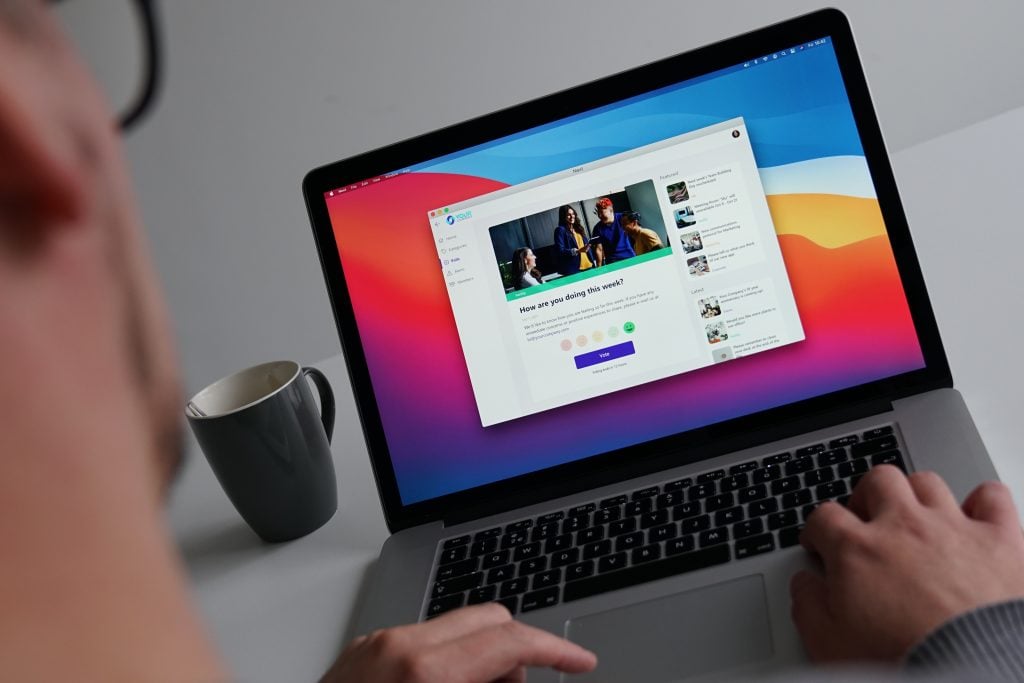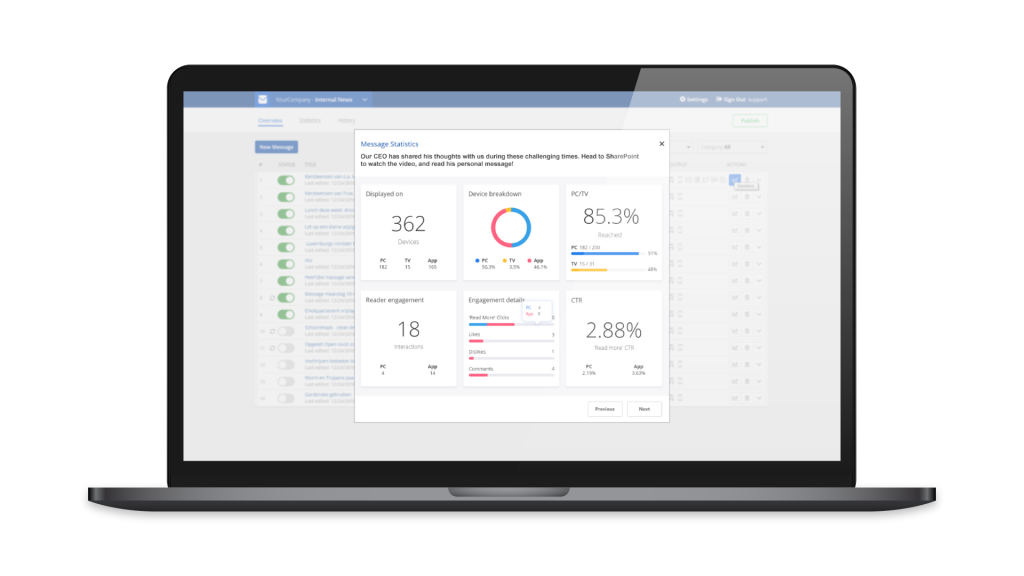Employee Communication vs. Internal Communication
Estimated reading time: 11 minutes
Effective communication is crucial to any organization’s success. Employee communication vs. Internal communication are two types of communication. While they may seem similar, they serve different purposes and use different channels to reach their target audiences.
Employee communication is information sharing between employees and their managers, coworkers, or teams. On the other hand, internal communication is a more comprehensive word that refers to any communication within an organization.
Building relationships, enhancing employee engagement, and fostering a healthy work environment depend on effective employee communication and internal communication. The rise in remote and hybrid workplaces triggers a growing need for an employee communication platform to encourage employee communication and collaboration.
Table of contents
- What is Employee Communication?
- Why is Employee Communication Important?
- Examples of Employee Communication
- What is Internal Communication?
- Why is Internal Communication Important?
- Examples of Internal Communication
- What is an Employee Communication Platform?
- The need for an effective employee communication platform
- Criteria for selecting the best employee communication platform
- Employee Communications Software on G2
- Features of an Employee Communication Platform
- Differences Between Employee Communication vs. Internal Communication
- Best Practices for Employee Communication vs. Internal Communication
What is Employee Communication?
Employee Communication refers to all communication between employees and their managers, or members of the team. Verbal communication can occur in meetings, one-on-one interactions, performance evaluations, or team-building exercises. Employee Communication can also happen electronically via various mediums, such as digital signage, employee apps, email, the intranet, collaboration tools, or an employee communication platform.
Why is Employee Communication Important?
Employee communication is important because it can help keep employees informed, engaged, productive, and safe. It can create an open culture, boost engagement and commitment, and increase trust, morale, productivity, and teamwork.
Examples of Employee Communication
Employee communication is exchanging ideas and information within a company between employees and management. Here are a few examples of employee communication:
- Managers and employees can communicate with one another during meetings to discuss critical topics and provide updates. Meetings can happen in person or virtual and can be official or informal. Goals, priorities, and progress can be discussed during regular team meetings.
- Managers and employees can develop trust and solid working connections in one-on-one interactions. These discussions can be utilized to address any problems, offer feedback, and talk about career goals.
- Performance evaluations allow managers and employees to discuss work performance and establish future goals. Employees can learn about their strengths and limitations and areas for improvement.
- Team-building exercises enable workers to collaborate and build strong relationships. These activities, which can be fun and challenging, can improve cooperation and communication.
- Employee communication software can assist in streamlining internal communication. Sending messages and sharing data are possible with these tools. They can also be utilized to provide updates and information to employees.
What is Internal Communication?
Internal communication is a broad term that encompasses all communication within an organization. This includes communication between departments, management, and employees, and even communication with external stakeholders. Examples of Internal Communication channels include email, intranet, newsletters, memos, and social media.
Why is Internal Communication Important?
Effective Internal Communication is important because it helps to create a unified message, promote transparency, and build trust between employees and management. When communication is clear and consistent, employees are more likely to feel informed and engaged with the company’s mission and values.
Examples of Internal Communication
Any organization needs effective internal communication to increase productivity, build strong relations, and ensure everyone is working toward the same objectives. Here are some examples of internal communication:
- Email is a popular method of communication that people use to communicate essential messages, files, and other information to one or more recipients. Email can be used to interact with team members or employees throughout the company. It is also effective for distributing updates and announcements.
- An intranet is an internal website that gives employees access to crucial data and assets. These include publications like company directories, HR policies and procedures, and news and announcements. A company’s intranet may effectively spread information throughout the organization and guarantee everyone access to the same information.
- Employees receive updates and news about the company through newsletters, which are published regularly. Newsletters can be used to foster company culture, share important updates, and celebrate accomplishments. They are a powerful tool for employee engagement and community creation.
- Memos are an informal form of internal communication that is often utilized for brief messages. They can be sent by email or a messaging platform and used to communicate with a certain group or person. Memos are a useful tool for quickly sharing updates and critical information.
- Social media can also be an effective internal communication tool when used correctly. It can be used to increase employee engagement and foster a sense of community. Social networking sites like Facebook, Twitter, and LinkedIn can be utilized to promote the company culture, news, and updates, and celebrate employee success stories.

What is an Employee Communication Platform?
An employee communication platform is a software platform that offers organizations several communication tools, unique features, and nifty integrations to communicate with employees wherever they are. These platforms typically include features like instant messaging, group chats and channels, video conferencing, file sharing and storage, mobile accessibility, integration with other tools and apps, an employee directory, surveys and polls, and analytics and reporting.
The need for an effective employee communication platform
Employee communication platforms have gained popularity in recent years, and the market has expanded with various solutions that cater to different needs. Organizations will have various options for employee communication platforms. These platforms have developed to include features like task management, file sharing, video conferencing, instant messaging, personalization, artificial intelligence, and much more.
Given the wide range of options available, choosing the appropriate employee communication platform for your organization might be difficult. There are many things to consider, including your company’s size, industry, and communication requirements. Yet, a reliable employee communication platform must consist of a wide range of communication channels, reach, include, and engage employees, and improve productivity. It should make communication easier, faster, and more efficient.
Criteria for selecting the best employee communication platform
Organizations must consider several criteria when choosing an employee communication platform. Businesses can choose the best platform for employee communication using the following criteria:
- Usability: The platform must be simple, intuitive, and straightforward. The platform should not require considerable training for employees to use it.
- Functionality: The platform should have all the necessary features for efficient (top-down) communication. The platform should also include personalization and be customizable to your branding.
- Security: The platform should have strong security measures to safeguard private data and critical corporate information. Some security measures to consider are encryption, multi-factor authentication, and user authorization settings.
- Integrations: The platform must work with other business tools, like productivity suites or project management software. Integrations ensure that data or content is not repeated on many platforms.
- Scalability: The platform needs to be scalable to support business expansion. The platform should be able to manage more users and communication channels as the organization grows.
- Customer service: The platform supplier must provide quick technical support. Organizations must have access to skilled support agents that can assist in problem-solving with any technical issues.
- Price: The cost of the platform is an essential factor to consider. The platform should offer a reasonable pricing structure that aligns with the organization’s budget and communication needs.
Employee Communications Software on G2
Every quarter, G2 publishes its new Grid Report for Employee Communications, where they award badges to businesses that have outdone themselves in their industries and received positive reviews from their customers. Netpresenter is happy to be part of the Leaders in the Employee Communications category. You can also check out our Grid position below.
.
Features of an Employee Communication Platform
An employee communication platform is a software solution designed to improve organizational communication and collaboration. Here are some key features of an effective employee communication platform:
- Instant messaging or commenting: A platform for employee communication should have a real-time messaging or commenting capability that enables fast and easy contact among employees. Emojis, acknowledgments, and the capability to send files should be part of this.
- Group chats and channels: Teams can connect and work together in a shared environment using group chats and channels. Teams should be able to build private or public channels that are dedicated to particular projects or themes on an efficient employee communication platform.
- Video conferencing: Video conferencing is crucial for remote teams or employees working from different places. Teams should be able to virtual meet using features like screen sharing, chat, and recording.
- File sharing and storage: These are crucial capabilities for teams working together on documents, spreadsheets, and other data types. Thanks to an efficient employee communication platform, teams should be able to exchange and access files from anywhere easily.
- Mobile accessibility: A good employee communication platform should be mobile-friendly, so users can connect and communicate while on the go. Both Android and iOS mobile apps should be a part of this feature.
- Integrations with other tools and applications: An employee communication platform should integrate with other tools and apps that the company uses, such as email, calendar apps, office 365, or project management software.
- Employee directory: A searchable database that lists every employee in an organization. Contact information and other relevant data should be included.
- Surveys and polls: To get input from employees, teams should be able to create surveys and polls on an employee communication platform. This function can be used to determine areas for development, gather feedback, and evaluate employee satisfaction.
- Analytics and reporting: A good employee communication platform should have analytics and reporting tools that let managers monitor indicators like employee engagement and open rates.

Differences Between Employee Communication vs. Internal Communication
Employee Communication focuses on how information is shared between employees and their managers, or members of the team. On the other hand, Internal Communication is a broader term that includes all communication within an organization. While both Employee Communication and Internal Communication are important for creating a positive work environment, the two have several key differences:
- Communication style: Information exchange between employees and their managers, or members of the team is called employee communication. It typically takes place informally and in a variety of ways. On the other hand, internal communication refers to sharing information within several teams, departments, and organizational levels. It is usually formal through memos, newsletters, and company-wide announcements.
- Communication’s goal: Employee communication is improving day-to-day operations, giving feedback, and building relationships among employees. It aims to increase team productivity, engagement, and collaboration. Yet, internal communication has a strategic advantage. It tries to educate employees on the organization’s objectives, goals, and vision.
- Target audience: Employees at the same level, members of the same team, or other particular target audiences are typically the target audiences for employee communication. It aims to improve teamwork and communication within the department or team. On the other hand, internal communication is directed toward all employees. Its main goal is ensuring every employee is aware of and committed to the organization’s mission, vision, and goals.
- Channels used: Various channels, including email, instant messaging, and employee communication platforms, can be used for employee communication. Formal channels for internal communication include memos, newsletters, and corporate announcements.
- Formality: Communication among employees is typically informal and unstructured. It enables more informal and personal communication between employees or target audiences. On the other hand, internal communication is typically formal and structured. One needs a more formal, business-like communication style to communicate the message clearly and successfully.
Best Practices for Employee Communication vs. Internal Communication
It is essential to establish best practices to improve employee communication vs. internal communication. Here are some key best practices for effective communication in the workplace:
- When managers and other leaders encourage employees to approach them with any problems or concerns, they implement an open-door policy. It creates a culture where workers feel heard and safe speaking their minds. This approach makes building trust and encouraging open communication between employees and management possible.
- Use of multiple channels: Giving employees regular feedback is a wonderful approach to ensure everyone is on the same page. Employees can understand their performance and where to improve with regular feedback sessions. Also, regular manager feedback can make employees feel appreciated and acknowledged for their efforts.
- Consistency in messaging: Messaging should be consistent across all channels to ensure clarity and prevent confusion. No matter the channel, messages must be precise, brief, and communicate the same purpose. This ensures that everyone is communicating effectively and that there are no misunderstandings.
- Active listening: To actively listen is to pay close attention and to fully engage in what is being said. Giving your colleagues your whole attention is crucial while attending to their issues. You can tell that you value your employees’ thoughts by how actively you listen to them.
- Encouraging two-way communication: You may promote two-way communication by fostering an atmosphere where employees feel comfortable discussing their ideas. It’s critical that employees and management communicate openly. Encouraging two-way communication can result in fresh perspectives and ideas that benefit the organization.
In conclusion of employee communication vs. internal communication, efficient communication is crucial for any organization to succeed. Building relationships between employees and management and fostering a healthy work environment depends heavily on internal and employee communication. An efficient employee communication platform can facilitate employee engagement and collaboration and increase productivity. Consider using a product like Netpresenter to improve communication in your office. Get in touch with one of our consultants; they will be happy to discuss your organization’s needs and show you everything our communication platform can offer you in a free 30-minute demo. Or download our free guide to find the right communication tools to reach your employees.

How can organizations align employee communication with broader internal communication strategies?
Integrate employee communication into the larger internal communication framework by:
Defining clear objectives and KPIs,
Coordinating messaging across departments,
Using feedback to refine and personalize content,
Ensuring leadership is visible and aligned with communication goals.
This strategic alignment enhances coherence and impact, helping the organization function more efficiently and cohesively.
What tools or channels should be used for successful employee communication?
Netpresenter tools suited for employee communication, include:
Digital signage for office-wide updates,
Screensavers and pop-ups for high-visibility messaging,
Mobile apps for remote and frontline access,
Targeted notifications based on role, department, or location.
Using a multichannel approach ensures that messages reach employees in the formats and contexts that work best for them.
How does effective employee communication impact organizational performance?
Effective employee communication results in:
Higher engagement and morale,
Better alignment with company goals,
Increased productivity,
Stronger culture and trust,
Lower turnover.
Clear, consistent communication empowers employees, reduces uncertainty, and fosters a sense of belonging—leading to better performance at all levels.
What is the difference between employee communication and internal communication?
While often used interchangeably, the article clearly differentiates the two.
Internal communication refers to all communication that happens within an organization, including between departments, leadership, and teams, regardless of the audience.
Employee communication, on the other hand, is a subset of internal communication that specifically focuses on the messages directed at employees to inform, engage, and motivate them. It’s more targeted and strategic in shaping the employee experience.
